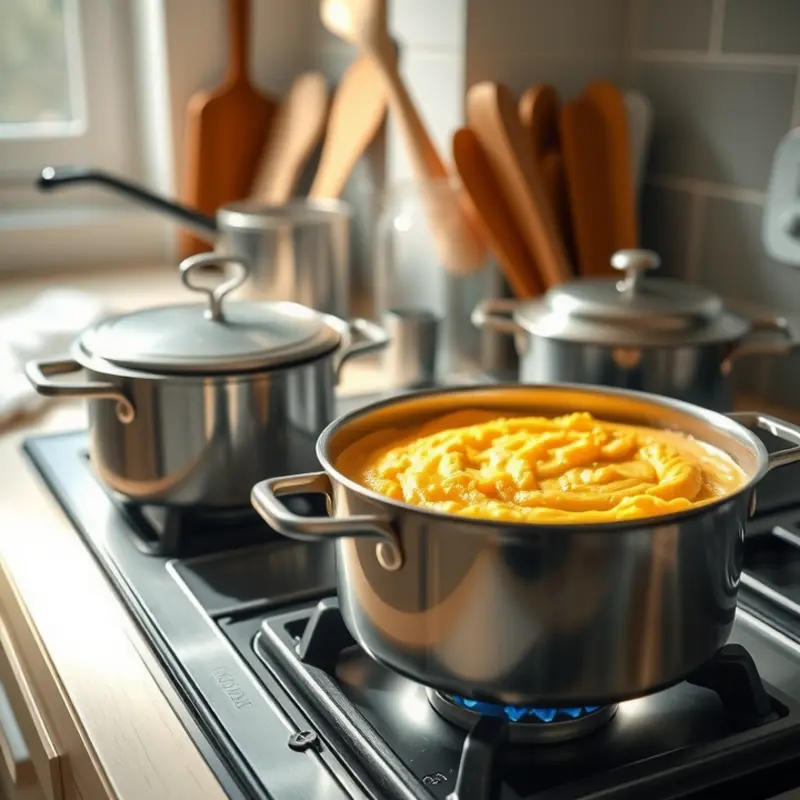Polenta, a classic Italian dish, can transform your home cooking experience. Whether you prefer a creamy consistency or a firmer slice, perfecting polenta requires attention to detail and the right techniques. In this guide, we’ll explore two main methods for achieving that ideal texture, ensuring you can impress your family and friends at the dinner table.
The Foundation: Choosing Your Cornmeal

Selecting the right cornmeal is the first step in mastering the art of polenta. The texture and flavor of your dish greatly depend on this foundational ingredient. Understanding the different types of cornmeal and their characteristics is the key to crafting a polenta that’s perfectly silky, creamy, or even robust and coarse.
Types of Cornmeal
Cornmeal can be categorized by grind size: fine, medium, and coarse. Each type offers a distinctive texture and is suited to different versions of polenta.
-
Fine Cornmeal: Perfect for achieving a smooth, creamy texture, fine cornmeal dissolves easily and cooks quickly. This type is ideal for those seeking a velvety polenta, akin to a rich porridge. However, be aware that fine cornmeal can become too gummy if overcooked.
-
Medium Cornmeal: This is the most versatile option. It provides a balance between creaminess and structure, yielding a texture that’s rich yet has a slight bite. Medium cornmeal is a popular choice for traditional polenta and works well when served with hearty sauces or stews.
-
Coarse Cornmeal: If you’re aiming for a more rustic, textured polenta, coarse cornmeal is your go-to. Its larger grains produce polenta with a delightfully granular consistency, offering a substantial mouthfeel. This type might require longer cooking time, but rewards with a distinct corn flavor.
Preparation Tips
Once you’ve chosen your cornmeal, preparation is key. Start by using a ratio of 4 parts liquid to 1 part cornmeal for a classic polenta base. For a lighter texture, consider incorporating milk or broth for part of the liquid. Bring the liquid to a gentle boil and gradually whisk in the cornmeal to prevent lumps. Reduce to a simmer, stirring occasionally to ensure even cooking and to avoid sticking.
Adjusting Texture
Depending on your desired outcome, the texture of polenta can be adjusted during cooking. For a looser, more spoonable polenta, add more liquid until you achieve the desired consistency. To create a firmer polenta suitable for grilling or baking, let it cook longer until a thicker mass forms. Once cooled, this can be sliced and finished with various methods such as frying or grilling.
For tips on optimizing your kitchen practices, explore this guide to eco-smart kitchen storage which includes sound advice for reducing waste while cooking.
Understanding the role each type of cornmeal plays in texture allows home cooks to approach polenta with newfound precision. The choice of cornmeal sets the stage for what comes next: enhancing flavors and finishing with finesse.
Cooking Techniques: Steps to Perfect Polenta

To achieve the perfect polenta texture, understanding and mastering different cooking techniques is crucial. Depending on your time and preference, you can either choose to cook it over the stove or bake it in the oven. Each method has its nuances, allowing you to tailor the texture to your liking.
Stovetop Cooking Method
The stovetop method is traditional and offers greater control over the texture as you can adjust as needed. Start by bringing water or broth to a gentle boil. The quality of your liquid is paramount, as it directly affects the flavor profile of the polenta. Using a robust broth can add depth, while water offers a more neutral base.
Once the liquid is simmering, gradually add your polenta. Using a whisk is essential here; it helps incorporate the grains smoothly without clumping. Lower the heat to a simmer and switch to a wooden spoon. Stir continuously for about 30 to 45 minutes, ensuring the grains are fully hydrated and the mixture thickens to a creamy consistency. Patience is a virtue with the stovetop method, as consistent stirring prevents lumps.
For an extra creamy result, consider adding dairy such as butter, cream, or cheese towards the end. This not only enriches the flavor but also enhances the smoothness. Remember, tasting as you go is crucial to adjusting seasonings and achieving the desired consistency.
Baking Method
If you prefer a more hands-off approach, baking polenta is an excellent method. Begin by preheating your oven to 350°F (175°C) and greasing a baking dish. Combine polenta, liquid, and seasonings in the dish, stirring until mixed. Cover the dish tightly with foil to retain moisture and place it in the oven.
Bake the polenta for about 40 minutes, then remove the foil and give it a good stir. This initial stint in the oven hydrates and swells the grains. If necessary, add more liquid at this stage. Return to the oven uncovered for an additional 10 to 15 minutes to create a more concentrated flavor.
This method allows you to walk away, making it ideal for preparing other aspects of your meal. Just ensure you occasionally check the consistency, adding liquid if it appears too dry.
Achieving the Right Consistency
A common challenge when preparing polenta is striking the right balance between thick and smooth. For softer polenta, suited for serving immediately, use a higher ratio of liquid. If aiming for a firmer texture ideal for grilling or baking later, reduce the ratio slightly.
For those exploring plant-based options, incorporating ingredients like coconut milk can provide creaminess without dairy. For more ideas on plant-based adaptations, explore easy plant-based eating.
Remember, polenta is forgiving and can be adjusted even after cooking. Stirring in extra liquid and reheating can help if it’s too thick. With these techniques, you’ll consistently achieve polenta with a perfect, velvety texture fit for any dish.
Final words
Perfecting polenta doesn’t have to be daunting; it’s an exciting culinary adventure that can add depth to your meals. By choosing the right cornmeal and mastering the cooking techniques, you can create polenta that’s rich, creamy, and tailored to your tastes. Remember to experiment with additional ingredients such as butter, cheese, or herbs to make your dish uniquely yours. With practice, you’ll serve polenta that will wow your guests and become a staple in your cooking repertoire.







